
 |
What does EPDM mean?
Ethylene Propylene Diene Monomer
Is there a warranty on EPDM?
Yes, black EPDM carries a 20 year warranty against weatherability and factory defects. Warranty excludes chalking.
Can EPDM be bonded directly over asphalt, tar, shingles, asphalt rolled roofing or felt paper?
No, the oils in pertroleum based products will cause EPDM to swell and fail. EPDM should be bonded over 5/8" plywood, 5/8" OSB board, or polyisocyanurate board with a fiberglass backing.
Can I install EPDM membrane directly over an existing roof?
You can install EPDM membrane over an existing roof only if a new layer of 5/8" plywood, 5/8" OSB board or polyisocyanurate board with a fiberglass backing is used as a barrier to protect the EPDM.
Can I bond EPDM membrane directly over plywood or OSB board surfaces?
The plywood or OSB board should be sanded to eliminate sharp edges, thoroughly cleaned, dust free and dry.
What is the temperature range for applying latex (water based) bonding adhesive?
Applying latex bonding adhesive requires an air temperature of 50 degrees Fahrenheit or above when applied. Temperature should remain above 50 degrees for at least 48 hours after application to allow the adhesive to set up. Latex bonding adhesive should be stored at 50-70 degrees Fahrenheit.
What is the temperature range for applying neoprene (solvent based) bonding adhesive?
Ambient air temperature should be 40 degrees fahrenheit or above for at least 24 hours after application. High humidity will cause adhesion problems. Never apply neoprene bonding adhesive in wet or humid conditions.
What is the coverage rate on neoprene (solvent based) bonding adhesive?
For application on plywood, OSB, polyisocyanurate board, brick, masonry or concrete: 75 sq. ft. per gallon. For application on a smooth metal surface: 100 sq. ft. per gallon
What is the coverage rate on latex (water based) bonding adhesive?
For application on plywood, OSB, or polyisocyanurate board: 125-150 sq. ft. per gallon
What EPDM thickness should I use?
45 mil EPDM is fine for most applications. However, thicker 60 or 90 mil EPDM might be preffered in applications where puncture resistance is important. For example, roof located in an area where tree limbs may fall.
Other than the EPDM, what else will I need for installation?
You will need bonding adhesive, paint roller, utility knife or scissors, push broom and we strongly recommend gloves and eye protection.
What roof slope is recommended where EPDM is installed?
For good roof drainage, we recommend 1/4" per foot.
Can I use EPDM roofing as a pondliner?
No, this is roofing grade material and is not aquatic safe. We carry a PONDGARD EPDM fishgrade liner.
Is EPDM roofing available in different colors?
EPDM is available in black and white on black. Black EPDM is very resistant to UV and ozone and has excellent sustainability and life. White on black EPDM is cooler and more energy efficient but has a shorter life than black EPDM. White on black EPDM will chalk over time. You can fin the White on Black EPDM under our RV Roofing section.
EPDM Roofing Installation
|
|
Seaming With Zip Tape
|
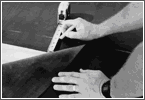 Overlap the two membranes 3" |
|
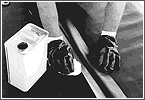 Clean seam area on both sheets |
|
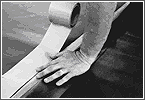 Apply Tape |
|
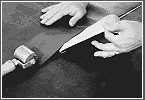 Slowly remove paper allowing 2 sheets to seam |
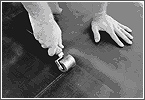 Roll seam area to completely secure the 2 sheets together |
|
|
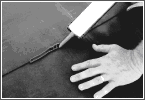 Apply bead of caulk to edge of seam |
Installation of Termination Bar
Some applications will require that the membrane go from a flat surfact to a 90° angle up an adjoining surface. To secure the membrane in this situation, it is recommended to use a termination bar. When adhering to the vertical wall leave about 1/2" unglued. Apply a bead of caulk between the membrane and the wall at this point. Now you are ready to fasten the term bar. When terminating on wood, screws may be used to fasten the bar. If terminating into concrete, you must drill holes and secure the bar with anchors. After the bar is in place, trim any excess membrane left above the bar. Now that the membrane is flush with the top of the bar, apply a bead of caulk along the top of the termination to finish the job. ( In corners it is recommended to cut the bar rather than bend it.)